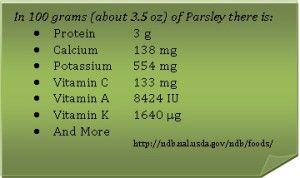Parsley is much more than a beautiful garnish to finish a plate, it is a great food in its own right.
Important constituents of parsley include flavonoids, chlorophyll, carotene (the precursor to vitamin A), vitamin C, calcium, sodium, magnesium and iron.
FLAVONOIDS
Mediterranean culinary herbs, such as parsley, are high in the flavone constituents. In general, the flavones are anti-inflammatory, anticarcinogentic, antioxident, antispasmodic, and antimicrobial.
These anti-inflammatory and anti-spasmodic properties make parsley effective in such conditions as IBS and PMS.
CHLOROPHYLL
All green plants are a rich source of chlorophyll. Chlorophyll purifies the body and reduces harmful bacteria and other microorganisms. This is what gives parsley its strong breath-freshening quality. Next time you are at a restaurant and have a sprig of parsley on your plate, don’t leave it – eat it. You will freshen your breath and increase your nutrition.
IMMUNE SYSTEM
The flavonoids mentioned above are anti-microbial which protects against harmful bacteria. Parsley also contains both vitamin C and carotene (precursor of vitamin A found in plant foods) to boost the immune system. Including parsley in your diet will give you these important vitamins and increase your protection against infection.
VITAMIN C
Other benefits of vitamin C include reduced cholesterol and saturated fats in the blood stream and collagen production (aiding in wound healing). Vitamin C is a natural anti-histamine, which reduces allergy symptoms of itchy, watery eyes and runny nose. It is also beneficial for the treatment of hives.
The adrenal glands contain high amounts of vitamin C, so it is vital that we include vitamin C in our diet to protect these hard-working glands that do so much for us as during our fast-paced, busy lives.
PARSLEY TEA
Making a tea is a great way to increase consumption of parsley. Drinking parsley tea benefits digestion and strengthens teeth. It is effective in treating UTIs due to its antimicrobial properties along with its diuretic action, increasing urination to flush out bacteria causing the infection. To make the tea, pour one cup of boiling water over 1/4 cup of fresh parsley. Let it steep for 5 minutes, strain out the herb and sweeten with honey and/or lemon juice if desired.
CAUTION
Parsley is generally a safe herb, but there are a few things to be aware of. It can make you more sensitive to the sun. The constituents that cause this are mostly found in the root, but if you easily burn use extra caution while you are in the sun if you are using parsley medicinally, since typically a medicinal dose is much higher than a culinary dose.
Nursing mothers should reduce or eliminate parsley use since parsley dries up milk production.
As you can see, it would be beneficial to include parsley to your diet. Easy ways to increase parsley consumption are to add fresh parsley to smoothies and to increase the use of parsley as a spice during cooking. The recipe I am sharing today uses parsley as one of the main ingredients.


- 1/2 cup medium-grain bulgur
- 2 cups boiling water
- 1 teaspoon salt
- 2 cups tomatoes, any variety
- 1/2 onion, red or sweet vidalia
- 1 cup packed fresh parsley
- 1/2 cup fresh mint
- 1/2 cup fresh basil
- 2 lemons
- 1/4 cup olive oil
- 1/2 teaspoon pepper
- Pita bread or chopped lettuce, for serving
- Put the bulgur in a heat-proof bowl that holds at least 2 quarts.
- Add the water and the salt to the bulgur and soak for about 30 minutes. You want it to be just tender.
- Drain and then press down the bulgur to remove as much water as possible.
- While the bulgur soaks, dice the tomatoes, discarding the seeds if they are too juicy.
- Mince the onion. If you don't have an onion, or prefer a milder flavor, you can substitute shallots, leeks or green onions.
- Wash and mince the fresh herbs.
- Zest and then juice both lemons. Mince the zest into small pieces.
- Mix the vegetables, herbs, lemon zest and juice, olive oil and pepper into the cooked bulgur.
- Stir to evenly mix the ingredients and refrigerate until chilled.
- Serve the tabouleh in a pita pocket or over a bed of lettuce.
- There are a lot of Tabouleh recipes posted on the internet. I adapted this one from one of my favorite recipe websites, Food52.com. You can find the original recipe at http://food52.com/recipes/17846-mediterranean-tabouleh
SOURCES:
http://ndb.nal.usda.gov/ndb/foods/show/3080?fgcd=&manu=&lfacet=&format=&count=&max=35&offset=&sort=&qlookup=PARSLEY
http://food52.com/recipes/17846-mediterranean-tabouleh
Pitchford, Paul (2002). Healing with Whole Foods: Asian Traditions and Modern Nutrition. (3rd ed.) Berkeley, CA: North Atlantic Books


